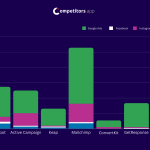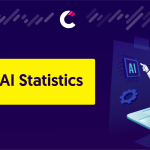The growing demand for AI is obvious in all markets. This page collects and will keep collecting the best AI statistics that we find across the web to ensure that everyone stays informed when it comes to AI. These insights are aiming to act as competitive insights that will give you an edge over competition.
General AI Statistics
- The global AI market is valued at over $136 billion, according to Grandview Research.
- AI industry value is projected to increase over 13x in the next seven years, as reported by Business Wire.
- The US AI market is forecasted to reach $299.64 billion by 2026, according to Statista.
- The AI market will expand at a CAGR of 38.1% between 2022 and 2030, as reported by Market Research Future.
- By 2025, 97 million people are expected to work in AI space, as per 24/7 Wall St.
- AI market size is expected to grow by at least 120% year-over-year, according to Markets and Markets.
- 83% of companies claim AI as a top priority in business plans, as reported by Forbes.
AI Adoption Statistics
- 35% of companies are using AI, and 42% are exploring the technology, according to Notta.
- 30% of IT professionals say employees use AI tools to save time, as per Statista.
- Over half of teleorganizations are invested in chatbots, as reported by Juniper Research.
- 47% of enterprises adopted AI in supply chains, according to Business Wire.
- 60% of businesses to use AI in data analytics by 2025, as reported by Forbes.
- 80% of CEOs plan to incorporate AI technologies within two years, according to Xometry.
AI Impact Statistics
- AI is estimated to contribute $15.7 trillion to the global economy by 2030, as per the World Economic Forum.
- AI is expected to create 20 million new jobs in the US by 2030, according to Accenture.
- AI could automate up to 800 million jobs globally by 2030, as reported by McKinsey & Company.
- AI is projected to save $2.6 trillion in healthcare costs by 2026, according to PWC.
- AI will reduce fraud in financial services by $1.2 trillion by 2030, as per Forrester Research.
AI Applications Statistics by Industry
- AI is used in over 70% of new smartphones, according to Hazelphone.
- AI is used in over 50% of new cars, as reported by Statista.
- AI is used in over 30% of new homes, as per Statista.
- AI is used in over 20% of new factories, according to Statista.
- AI is used in over 10% of new hospitals, as reported by Statista.
AI Challenges and Ethics Statistics
- 62% of people are concerned about AI used for malicious purposes, according to Pew Research.
- 48% of people are concerned about AI bias, according to Statista.
AI Replacing Jobs Statistics
AI is predicted to eliminate 85 million jobs but create 97 million new ones by 2025. Globally, AI might replace 300 million full-time jobs and could account for over 52% of job displacement globally by 2025. Potentially, 30% of jobs could be automated by 2030. AI Hungry
AI in Healthcare Statistics
- The AI radiology market is expected to surpass $3 billion by the end of 2023. ZipDo
- The global artificial intelligence in healthcare market size was valued at USD 15.4 billion in 2022 and is expected to expand at a CAGR of 37.5% from 2023 to 2030. Grand View Research
- The healthcare AI market is expected to reach $20.65 billion by 2023. By 2030, the market value for AI in healthcare will reach $272.91 billion. Market Splash
AI Art Statistics
27% of Americans have seen AI-generated art; 74% of artists believe AI artwork is unethical; the highest-valued piece of AI art sold for $432,000; 53% worry about AI-generated images spreading fake news. Academy of Animated Art
AI in the Workplace Statistics
- 63% of people trust AI machines more than their human managers
- 54% of business executives say that AI solutions have increased productivity
- 37% of organizations have implemented some form of AI.
AI Replacing Jobs
- Global Impact: AI is expected to replace 800 million human jobs by 2030, creating 97 million new jobs worldwide by 2025. Financial companies may spend up to $110 billion on AI by 2024. Soocial
- Current Trends: In May 2023, 3,900 US job losses were directly linked to AI. 14% of workers reported losing their jobs to robots. SEO.ai
- Long-Term Predictions: AI might replace 300 million full-time jobs globally, with 47% of U.S. employment at risk of computerization within 20 years. AI could account for over 52% of job displacement globally by 2025. AIHungry
AI in Healthcare
- Market Growth: AI radiology market to surpass $3 billion by the end of 2023. Global AI in the healthcare market will be valued at $15.4 billion in 2022, with an expected CAGR of 37.5% from 2023 to 2030. ZipDo
- Healthcare AI Market Value: Market is expected to reach $20.65 billion by 2023. US growth rate at 36.1% per year. US accounts for 58% of global market revenue. MarketSplash
- Future Projections: Market value for AI in healthcare is expected to reach $272.91 billion by 2030. MarketSplash
AI in Art
- Public Perception and Sales: 27% of Americans have seen AI-generated art. 74% of artists believe AI artwork is unethical. Highest-valued piece sold for $432,000. Academy of Animated Art
- Generational Views: Varying opinions across generations on whether AI-created images and videos should be considered art. Statista
AI Marketing Statistics
- Market Size: The AI industry in marketing is currently valued at $15.84 billion and is expected to exceed $100 billion in the next five years. Businessolution.org
- Adoption Rates: In 2023, 73% of U.S. marketers reported using generative AI tools, such as chatbots, in their strategies. Statista
- Market Revenue: Global market revenues of AI in marketing are expected to grow from $27.4 billion in 2023 to $107.4 billion. Statista
- The AI industry in marketing is valued at $15.84 billion and is expected to exceed $100 billion over the next five years.
- AI is used for marketing purposes by 28% of top companies. Business Solution
Discover the top AI Marketing Tools from our list.
AI in the Workplace Statistics
- Employee Engagement: Over 90% of employees admit to using at least one AI tool in their jobs, although only 44% acknowledge using AI in their personal life. Forbes
- Investment Trends: In 2023, 63% of companies plan to increase or maintain their spending on AI and machine learning. CompTIA
- Future Predictions: By 2025, AI is predicted to handle 95% of all customer interactions. ZipDo
AI for Statistics Problems
- AI Tools for Math and Stats: AI tools like Wolfram Alpha, GeoGebra, Symbolab, and Minitab are known for their precision and adaptability in solving a wide range of mathematical and statistical problems. MyMathsClub
Conversational AI Statistics
- Market Growth: The global conversational AI market, including chatbots and virtual assistants, is expected to grow at a CAGR of 30.2% to $22.6 billion by 2024. HubType
- Business Impact: 90% of businesses using chatbots for customer support saw a cost of just $0.70 per interaction and saved up to 4 minutes per inquiry. HubType
- Sector Savings: Retail, banking, and healthcare sectors are projected to realize annual business cost savings of $11 billion by 2023, up from $6 billion in 2018. HubType
AI in Education
- Teacher Workload: Current technology can automate 20% to 40% of teachers’ workload. An AI-enabled chatbot can respond to a student’s question in about 2.7 seconds. Soocial
- Market Value and Growth: The global market value of AI in education surpassed $2 billion in 2021 and is expected to grow significantly. By 2023, the market is projected to reach approximately $3.68 billion. Market Research Future
- Teacher and Classroom Use: Nearly 4 in 10 teachers expect to use AI in their classrooms by the end of the 2023-24 school year. Education Week
AI Writing
- Business Use and Adoption: 37% of businesses deploy AI, with 12% using AI specifically for content creation. Don’t Do It Yourself
- Content Generation Tools: 62% of B2B and 38% of B2C businesses plan to use AI content generation tools in 2023. Siege Media
- AI Writing Classes: AI writing tools are categorized into AI text prediction, AI text editors, and AI text generators. Triple A Review
AI Efficiency
- Business Applications: Businesses are employing AI in various ways to improve efficiencies, save time, and decrease costs. Forbes
- Economic Impact and Trends: The AI Index 2023 covers AI’s impact on technical performance, education, policy trends, economic impact, and job scene. Stanford HAI
- Generative AI and Performance: Leading companies report that at least 20% of their EBIT in 2022 was attributable to AI use, indicating AI’s significant contribution to efficiency and creativity. McKinsey
AI in Recruitment Statistics
- Reduced Bias in Hiring: 68% of recruiters believe AI will help remove unconscious bias from the hiring process. However, 48% of hiring managers admit to having bias, which can negatively impact applicants’ interviews. Zippia
AI Bias Statistics
- Continuous Growth in Bias Metrics: Since 2016, there has been a continuous increase in the metrics used to analyze fairness and biases in AI platforms. This highlights a growing awareness and effort to understand and manage AI bias more effectively. Statista
- Research and Recommendations: The National Institute of Standards and Technology (NIST) emphasizes the need to broaden the scope of identifying and managing AI biases beyond the machine learning processes and data used for training. This suggests an evolving approach to tackling AI bias. NIST
- Rising Interest and Efforts to Mitigate Bias: Interest in AI is increasing, with more individuals and businesses recognizing its benefits. Consequently, there’s a heightened focus on understanding the types of AI bias and exploring ways to mitigate it. AIMultiple
Theo Kanellopoulos








